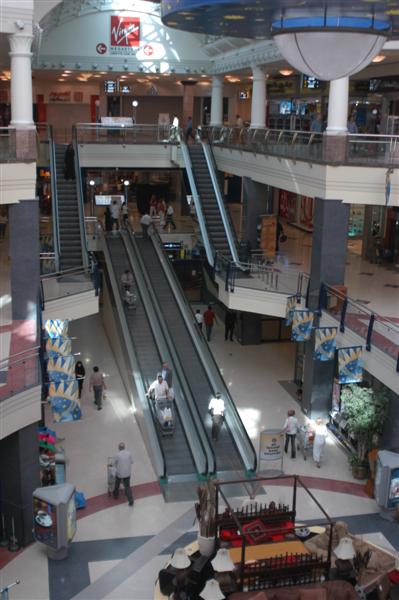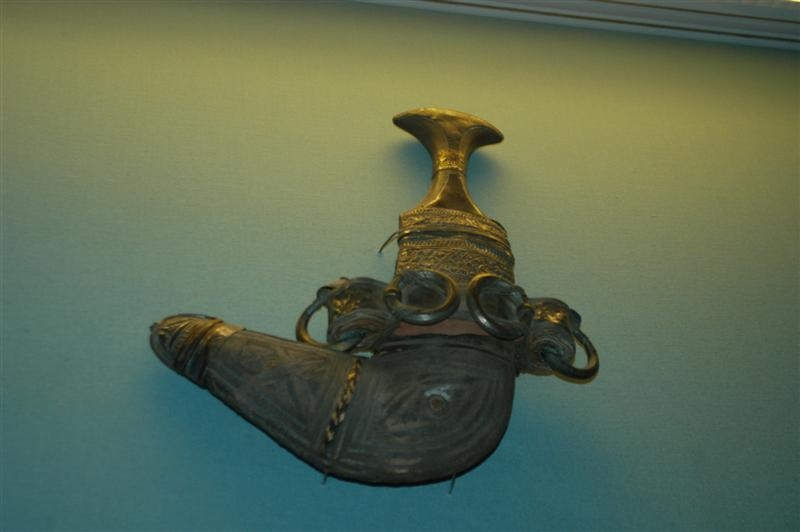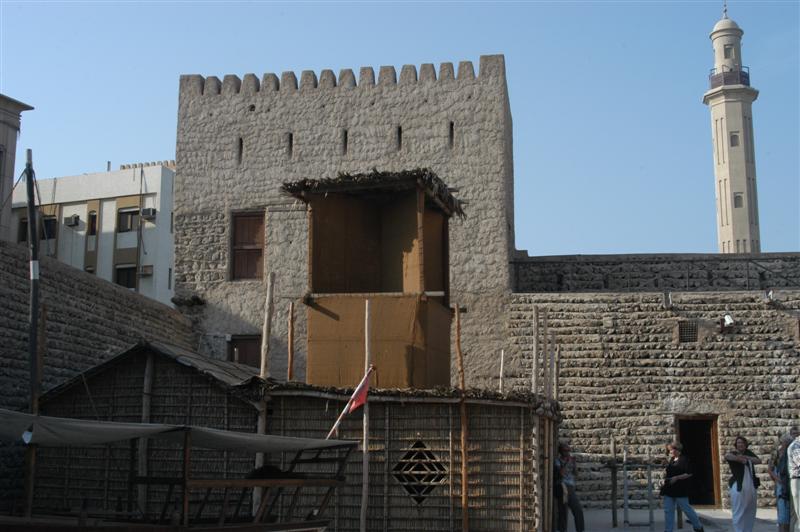October 15 - October 17. DUBAI Our flight arrived into Dubai very early in the morning. The plane had been almost empty so we'd each had our own row. I was curled up asleep with my knees to my chest when the plane started to show signs of landing. It was still dark outside and as we started to approach the airport I looked out my window and saw lines of lights stretching across the black surface. They seemed awfully long for a runway I had thought and later learned that they were the UAE's extensive and well-built system of freeways. We were groggy and stiff from the short over-night flight but found ourselves awakened by the dramatic change in our surroundings. The Dubai airport was a modern appar ition that instantly jolted us out of four months of rugged travel in Africa. ition that instantly jolted us out of four months of rugged travel in Africa.
As we followed the flow of people through the airport, along raised walkways and down escalators, we had a glimpse into the massive mall that we all know from Dubai's tourism commercials, equipped with duty-free shopping galore. We eventually came to an area where people were filling out visa applications. Supposedly we could get a two-week visa upon arrival but we didn't know if we had to fill out an application so we approached the nearby information desk. We found a woman dressed in a abeyya, a long black cloak that covered her from head to foot. On her head was a black scarf, called a shayla, neatly covering all of her hair. When she looked up I was drawn to her dark eyes, accentuated by heavy black eye liner. In the sterile modern surroundings of the airport I found myself quickly reminded that I was in the UAE, a wealthy and modern enclave of the Middle East. She directed us straight through to the immigration line, no application required. A man dressed in a long white dish-dasha swiftly stamped our passports we were on our way.
By the time we rolled our bags out of customs the sun was up and the sky was getting lighter. We hadn't been able to find a guidebook for Dubai while we were in Africa so we were at the mercy of the freebies they handed out at the tourist information booth. We had thought that the famous mall at Dubai's airport would sell guidebooks but it appeared that there was no way to get inside unless we went back through the arrivals area and checked in. Fortunately we had our reservation at the Holiday Inn so we didn't have to sweat the lodging search. And I do mean sweat. I stood near the door looking at the brochures while Rob went to change money. Each time the automatic doors swung open I could feel the warm air and it was still just early morning.
Getting to the Holiday Inn was easy enough. We just hopped in one of the shiny clean cabs that were waiting outside. The airport wasn't even very far from downtown. That didn't mean it was a particularly cheap ride for a couple of backpackers but we were in Dubai and it wasn't a cheap place. We could have tried to figure out the buses but with that nice hotel room waiting we just didn't have the patience or the energy.  Zipping through Dubai's streets we observed a quiet city with clean and wide streets, neat concrete buildings, and practical modern signage. Just as we turned to approach our hotel from the back I noticed a shwarma stand closing up. It was October 15th, the first day of the month-long Ramadan fasting period for all Muslims. For strict Muslims that meant no consuming of anything, even water, from sunup to sundown so people rose early to eat before the sun came up. It appeared that we had just missed the morning rush. Zipping through Dubai's streets we observed a quiet city with clean and wide streets, neat concrete buildings, and practical modern signage. Just as we turned to approach our hotel from the back I noticed a shwarma stand closing up. It was October 15th, the first day of the month-long Ramadan fasting period for all Muslims. For strict Muslims that meant no consuming of anything, even water, from sunup to sundown so people rose early to eat before the sun came up. It appeared that we had just missed the morning rush.
The Holiday Inn was nothing to get too excited about from the outside. I was just your typical business class hotel, a blocky mirror windowed building with maybe a dozen stories. The main entrance was on a smaller backstreet where a bellman came out to help us with our luggage, probably disappointed to see two grungy backpackers roll out of the taxi. The lobby was small, the coffee shop was closed, but the service was good. We received a nice room with a king-sized bed. It looked just like any other Holiday Inn hotel room the world over except that instead of having a Bible in the bed-side stand there was a green arrow pasted on the corner of the stand pointing towards Mecca. Legally we couldn't eat in public during the daylight hours either but we could order room service inside the hotel. We were too tired to eat and just ordered a bottle of water before getting cleaned up and sinking into bed. We watched a bit of TV but mostly just slept until the afternoon.
When hunger finally overcame us we went out in search of food. The hotel restaurants were closed but would be opening in a couple of hours. We checked out the ones on the rooftop next to a small pool. The heat was stifling and as inviting as the pool looked I suspected that I wouldn't be taking a dip during our stay. Bathing suits were allowed inside the hotels but generally considered inappropriate by local standards and I had no desire to be a point of interest for anybody. Leaving the hotel restaurants behind we went to the front desk and asked a man at the front desk to recommend a good shwarma restaurant. It turned out that he was from Jordan so we had to tell him that the best shwarma we'd ever had was on the second circle in Amman. He happily pointed us in the direction of a place on the other side of the river. It wasn't fancy, he said, but they had the best shwarma. With the sun starting to go down we left the hotel on foot, cutting over to one of the main boulevards. There were few people out and about but we could see the local restaurants beginning to prepare for iftar, the Ramadan evening meal. We noticed a surprising number of western chain food places including Starbucks and Cinnabon, but none of them were open. We also looked into other hotels. Our special rate at the Holiday Inn wouldn't be extended beyond the nights we had reserved so we checked out the Quality Inn, among others. With an easy pace, the late afternoon heat was comfortable and it felt good to get out and stretch our legs a bit. But when we reached a major crossing and saw a taxis as a bus station we decided to grab a cab and head to the shwarma restaurant. also looked into other hotels. Our special rate at the Holiday Inn wouldn't be extended beyond the nights we had reserved so we checked out the Quality Inn, among others. With an easy pace, the late afternoon heat was comfortable and it felt good to get out and stretch our legs a bit. But when we reached a major crossing and saw a taxis as a bus station we decided to grab a cab and head to the shwarma restaurant.
We just had the restaurant name, Al Daya, and street, Al Diyafa, to go off of but it was a well-know street so the taxi immediately knew where to go. It turned out to be farther than we expected but we were willing to go the extra mile for good shwarma. We had to cross the Dubai Creek, more like a large river, and head south for a ways. We couldn't initially find the place so we just had the cab let us out and we asked around until we found it. It was your basic shwarma place with big spits of sliced meat roasting in the back, neon lighting, and stark practical decor but the portions were generous and the shwarma were very good. There were tables on the sidewalk where we sat and stuffed ourselves while we took in out new surroundings. Al Difaya Street was full of restaurants and shopping and across the street we found a bookstore well stocked with English books. A few doors down we found an Internet cafe where we could send off an email update.
The Internet cafe turned out to be run by a group of Pilipino women. A great many other people we saw around Dubai looked South Asian. It was becoming quite apparent to us that the UAE's immigrant population was rather large. We later learned that under 20% of the population were actual Emiratis, making 80% of the population expatriate workers. Half of the 80% were South Asians, 23% were other Arabs or Iranians, and about 8% were westerners. From reading the newspapers while we were in Dubai we learned that not all of these people had such great lives in the UAE. Western expats generally benefited from corporate support and were only in the UAE for temporary assignments. The other expats were a different story. They earned more money than they could back in their home countries, which kept them in the UAE for years and years, but they didn't always have good working or living conditions and never could become citizens. During our whole stay in the UAE I can't actually say for sure if we talked to any Emirati. Every time we asked someone where they were from it was somewhere else.
Our plans for the UAE were pretty open but with the higher daily expense we didn't want to end up there too long. We needed to arrange for a flight to Sri Lanka, the Maldives or India as soon as possible, wherever was most cost-effective. The one thing we definitely wanted to do before we left was to see the Burj Al Arab and drive through the Emirates, and maybe over to Oman. But, in order to make our plans we needed a guidebook. Unfortunately, LP UAE book was old and difficult to find so we either had to get a book on the whole Arab peninsula or one just on Dubai. We searched and searched for the UAE book before we finally decided to just buy the 2002 Dubai book. The 2004 version had just been released but was expensive and was in LPs new city guide format which just lacked the detail we needed. Our search took us to Dubai's well stocked world of duty-free shopping malls, the city's trademark industry. While the UAE has a large petroleum industry, Dubai generates 89.6% of its income from non oil-based industries and about 70% of the UAE's non-oil based industry is generated in Dubai. The big business is Dubai is trade, specifically the re-export business. Beginning in the 1930s, with the collapse of the traditional pearling trade, merchants began importing goods which they turned around and sold to other ports, especially gold to India. India banned gold imports in 1947 to stabilize its currency which caused the price of gold in India to soar. In 1967 the price of gold in Dubai was $35/ounce while it was $68/ounce in India. The gold re-exportation peaked in 1997 when 660 tons of gold left Dubai. Today this kind of trade continues but is concentrated on Iran where VCRs and Levi's jeans are exchanged for caviar and carpets. The kind of wealth this brings to Dubai is evident in the modern expanse of the city with modern infrastructure, classy hotels and resorts, and fancy cars. (continued...) 2002 Dubai book. The 2004 version had just been released but was expensive and was in LPs new city guide format which just lacked the detail we needed. Our search took us to Dubai's well stocked world of duty-free shopping malls, the city's trademark industry. While the UAE has a large petroleum industry, Dubai generates 89.6% of its income from non oil-based industries and about 70% of the UAE's non-oil based industry is generated in Dubai. The big business is Dubai is trade, specifically the re-export business. Beginning in the 1930s, with the collapse of the traditional pearling trade, merchants began importing goods which they turned around and sold to other ports, especially gold to India. India banned gold imports in 1947 to stabilize its currency which caused the price of gold in India to soar. In 1967 the price of gold in Dubai was $35/ounce while it was $68/ounce in India. The gold re-exportation peaked in 1997 when 660 tons of gold left Dubai. Today this kind of trade continues but is concentrated on Iran where VCRs and Levi's jeans are exchanged for caviar and carpets. The kind of wealth this brings to Dubai is evident in the modern expanse of the city with modern infrastructure, classy hotels and resorts, and fancy cars. (continued...) |
DUBAI
I: Oct 15-17
II: Oct 15-17
I: Oct 18-19
II: Oct 18-19
AL AIN
Oct 20
Buraimi
(Oman)
Oct 21
OTHER
EMIRATES
Oct 22
ABU DHABI
Oct 23-24 |

